2024 Annual holidays and events

January
[ Day: 1 - 3 ] New Year Holidays (Sanganichi)

A time when Japanese people eat “osechi-ryori” (special New Year’s dishes) with ingredients representing longevity and good health. Hatsumode is the term for the first shrine or temple visit of the year, when people pray for wellbeing for the coming year.
[ Day: The second Monday of January ] Coming of Age Day (Seijin no hi)

- National holiday
- ◯
It is a day where young people are welcomed into adulthood by society. In Japan, youth are officially considered adults at age 20. It is a public holiday where eremonies are held across the country in city halls, ward offices, and other official centers.
January
[ Day: 1 - 3 ] New Year Holidays (Sanganichi)

A time when Japanese people eat “osechi-ryori” (special New Year’s dishes) with ingredients representing longevity and good health. Hatsumode is the term for the first shrine or temple visit of the year, when people pray for wellbeing for the coming year.
[ Day: The second Monday of January ] Coming of Age Day (Seijin no hi)

- National holiday
- ◯
It is a day where young people are welcomed into adulthood by society. In Japan, youth are officially considered adults at age 20. It is a public holiday where eremonies are held across the country in city halls, ward offices, and other official centers.
February
[ Day: 3 ] Bean-throwing Festival (Setsubun)

Soybeans are thrown on this day to get rid of evil and bring in good fortune. It is said that if you eat the same number of beans as your age, you will not catch a cold.
[ Day: 2/4-2/11(2024) ] Sapporo Snow Festival

- Event Location
- Sapporo city, Hokkaido
One of the largest winter events held in Japan, the festival is held annually in Sapporo. An International Snow Sculpture Contest has been held at Odori Park site since 1974.
[ Day: 11 ] National Foundation Day (Kenkoku kinenbi)
- National holiday
- ◯
Sometimes referred to as Emperor Day, it celebrates the mythological foundation of Japan and recognizes the acsension fo the first emperor, Emperor Jimmu.
[ Day: 14 ] Valentines day
On this day in Japan, women give chocolate to confess their love to men. Recently, giving out “giri-choco” (obligation chocolate) to male co-workers has become a common practice as well.
[ Day: 23 ] Emperor's Birthday (2020-)
- National holiday
- ◯
Celebrated on the day of birth of the current emperor.
March
[ Day: 3 ] Hinamatsuri (Doll Festival)

This day wishes for and celebrates the wellbeing and growth of girls. Dolls which are meant to carry ill fortune in place of ones daughter is put on display in homes.
[ Day: 14 ] White Day
A day when men may give a gift in return for chocolate received on Valentines's Day. Gifts of white chocolate and marshmallows are common.
[ Day: 20 ] Spring Equinox Day (Shunbun no Hi)
- National holiday
- ◯
The day that commonly marks the first day of spring
April
[ Day: 14-15 ] Takayama Festival (Spring)

- Event Location
- Hie Shrine, Gifu Pref.
The Takayama festival (spring) is the annual festival of the Hie Shrine in the southern half of Takayama's old town. Since the shrine is also known as Sanno-sama, the spring festival is also called Sanno Festival.
[ Day: 29 ] Showa Day
- National holiday
- ◯
It honors the birthday of Emperor Shōwa (Hirohito), the reigning emperor from 1926 to 1989. The holiday encourages public reflection on the turbulent 63 years of Hirohito's reign
[ Day: End of April to beginning of May ] Golden week
With four consecutive national holidays, Golden week is one of the biggest vacation periods in the year when many take the whole week off.
May
[ Day: 3 ] Constitution Memorial Day (Kenpou Kinenbi)
- National holiday
- ◯
A part of Golden Week, it takes place to commemorate the declaration of the 1947 Constitution, and is a time to reminisce the events of Japan's history.
[ Day: 3-4 ] Hakata Dontaku

- Event Location
- Fukuoka city, Fukuoka Pref.
One of the major festivals held in Fukuoka City, it is a historical event that has gone on for almost 800 years.The word 'dontaku' comes from the Dutch word 'zondag' that means both "Sunday" and "holiday".
[ Day: 4 ] Greenery Day (Midori-no hi)
- National holiday
- ◯
It is a day to commune with nature and to be thankful for blessings.
[ Day: 5 ] Children's Day (Kodomo no hi)

- National holiday
- ◯
Also known as boys day, the day celebrates children's health and happiness. On this day, families raise koinobori, carp-shaped windsock, and the way it blows in the wind looks like they are swimming.
[ Day: TBD (Odd years only) ] Kanda Festival

- Event Location
- Kanda shirine, Tokyo
One of 3 great Shinto festivals in Tokyo. Celebrates Tokugawa Ieyasu's victory at the battle of Sekigahara. The current form of the festival is held in honor of the kami of Kanda Myōjin (Kanda Shrine) and alternates with the Sanno festival.
[ Day: 3rd weekend of May ] Sanja Festival

An annual festival in the Asakusa district that usually takes place over the third full weekend in May. Held in celebration of the three founders of Sensoji Temple, enshrined in Asakusa Shrine next door to the temple, it is one of Tokyo's most popular festivals.
June
[ Day: 7-17 ] Sanno Festival

- Event Location
- Sanno Shirine, Tokyo
One of the three great festivals in Tokyo, celebrations encompass a number of activities and celebrations over a week.
July
[ Day: 3rd Monday of July ] Marine Day (Umi no hi)
- National holiday
- ◯
Also known as Ocean Day or Sea Day, the holiday's purpose is to give thanks to the ocean's bounty and to consider the importance of the ocean to Japan as an island nation.
[ Day: 1-31 ] Gion Festival (highlight 17 and 24)

- Event Location
- Gion, Kyoto
Taking its name from Gion district in Kyoto, it takes place annually and lasts for the whole month of July. The streets are lined with food stalls at night.
[ Day: 5-9 ] Yosakoi Soran Festival

- Event Location
- Sapporo city, Hokkaido
Held in the northern prefecture Hokkaido, a unique festival that incorporates Yosakoi’s original percussion instrument naruko, and Hokkaido’s folk song Soran-bushi. Both the instrument and the folk song are famous on their own and known by many Japanese.
[ Day: 7 ] Star Festival (Tanabata)
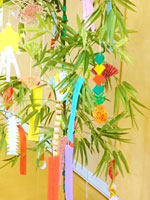
Bamboo trees are decorated with small pieces of paper with wishes written on them.
[ Day: 14 ] Nachi Fire Festival
- Event Location
- Kumano Nachi Taisha Shrine, Wakayama Pref.
Known locally as Nachi-no-Ogi, this festival is a purification ritual that ends with 12 portable shrines being set ablaze. One of the most dramatic and famous festivals in the region.
[ Day: 25 ] Tenjin Festival
- Event Location
- Tenmangu Shrine, Fukuoka Pref.
The festival of the Tenmangu Shrine, the festival celebrates its principle deity Sugawara Michizane.
[ Day: 28 ] Sumida River Fireworks Festival

- Event Location
- Tokyo
An annual fireworks festival held on the last Saturday in July, over the Sumidagawa near Asakusa. The Sumidagawa Hanabi Taikai follows the Japanese tradition of being a competition between rival pyrotechnic groups.
August
[ Day: 2-7 ] Nebuta Festival
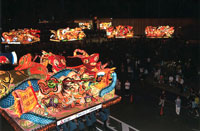
- Event Location
- Aomori city, Aomori Pref.
"Nebuta" refers to the float of a brave warrior-figure which is carried through the center of the city, while dancers wearing a unique type of costume called haneto dance around in time with the chant rasserā. A fireworks show is held on the evening of the final day.
[ Day: 3-6 ] Akita Kanto Festival

- Event Location
- Akita city, Akita Pref,
It is a festival celebrated in hopes of a good harvest in Akita City. Around two hundred bamboo poles five to twelve metres long, bearing twenty-four or forty-six lanterns are carried through the streets at night by festival participants.
[ Day: 5-7 ] Yamagata Hanagasa Festival

- Event Location
- Yamagata city, Yamagata Pref.
It celebrates the traditional music and dance of the region in one of Tohoku's largest parades. The hanagasa is a hat embroidered with red safflowers and used by the performers in their traditional dance. Some 10,000 local dancers follows gorgeously decorated floats.
[ Day: 6-8 ] Sendai Tanabata Festival

- Event Location
- Sendai city, Miyagi Pref.
The Sendai Tanabata Matsuri which attracts over two million visitors each year. While festivities take place throughout Downtown Sendai, the festival's main feature are thousands of colorful streamers that decorate the city's shopping arcades.
[ Day: 11 ] Mountain Day (Yama-no hi)
- National holiday
- ◯
Mountain Day is intended is to provide "opportunities to get familiar with mountains and appreciate blessings from mountains”. where Shinto beliefs in nature have shaped the culture, should celebrate its peaks and mountains.
[ Day: 9-12 ] Yosakoi Festival

- Event Location
- Kichi city, Kochi Pref.
A unique style of dance that originated in Japan and is performed at festivals and events all over the country, yosakoi is a highly energetic form of dance, and combines traditional movements with modern music.
[ Day: 12-15 ] Awa odori

- Event Location
- Tokushima city, Tokushima Pref.
The most famous of many dance festivals held in Japan during the Obon season in mid August. Awa is the former name for Tokushima Prefecture while odori means dance.
[ Day: 13-16 ] Obon
A Buddhist festival for honoring ones ancestors, when people visit family graves.It is a time when Buddhists remember people in their family who have died.
[ Day: 10 (To be postponed in case of rain) ] Jingu Gaien Fireworks Festival

- Event Location
- Meiji Jingu Gaien, Tokyo
The Jingu Gaien Fireworks Festival has attracted nearly a million visitors each year. Large and small starmines are a highlight of the 12,000 colorful fireworks that light up the Tokyo night sky.
September
[ Day: 3rd Monday of September ] Respect for the Aged Day (Keirou-no hi)
- National holiday
- ◯
This day is celebrated annually to honor its elderly citizens. Japanese media take the opportunity to feature the elderly, reporting on the population and highlighting the oldest people in the country.
[ Day: 15-16 ] Kishiwada Danjiri Festival
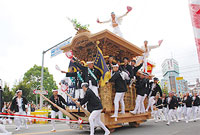
- Event Location
- Kishiwada city, Osaka
One of the oldest, most lively, yet most dangerous festivals in the Kansai region. A danjiri is a traditional Japanese wooden float has elaborate carvings and is decorated with various ornaments, that are pulled around a pre-set route on the day of the festival.
[ Day: 23 or 24 ] Autumnal Equinox (Shuubun-no hi)
- National holiday
- ◯
The holiday had its roots in Shinto traditions as a time to give thanks to the deities for a successful harvest.
October
[ Day: 7-9 ] Nagasaki Kunchi
- Event Location
- Suwa Shrine, Nagasaki Pref.
Held annually in Nagasaki, the festival of Suwa Shrine incorporates different aspects of Chinese and Dutch cultures, which have played a role in the city's history. The highlights are the dance and show performances by Nagasaki's various group.
[ Day: 9-10 ] Takayama Festival (autumn)
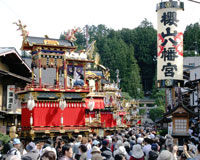
- Event Location
- Hachiman Shrine, Gifu Pref.
The annual festival of the Hachiman Shrine in the northern half of Takayama's old town, it is also known as Hachiman Festival.
[ Day: 2nd Monday in October ] Health/Sports Day (Taiiku-no hi)
- National holiday
- ◯
It commemorates the opening of the 1964 Summer Olympics held in Tokyo.The aim is to promote sports and an active lifestyle to ensure a healthy mind and body.
November
[ Day: 3 ] Culture Day (Bunka-no hi)
- National holiday
- ◯
For the purpose of promoting culture, the arts, and academic endeavor.
[ Day: 15 ] Shichi-go-san
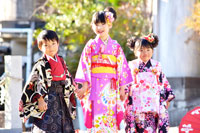
Shichi-Go-San (literally “seven-five-three”) is a Japanese custom observed in which five-year-old boys and three- and seven-year old girls visit shrines to pray for health and prosperity.
[ Day: 23 ] Labor Thanksgiving Day (Kinrou Kansha-no hi)
- National holiday
- ◯
The holiday cites it as an occasion to commemorate labor and production and give one another thanks.
December
[ Day: 25 ] Christmas
In Japan, Christmas is often celebrated on Christmas Eve. Few people attend church services, but towns and cities are beautifully decorated with Christmas lights and ornaments
[ Day: 31 ] Oomisoka (New Years Eve)
It is traditional to eat soba noodles (toshikoshi soba) with ones family during the night to wish for longevity. At midnight, the temple bell is struck 108 times to mark the end of the old year and the beginning of the new one.